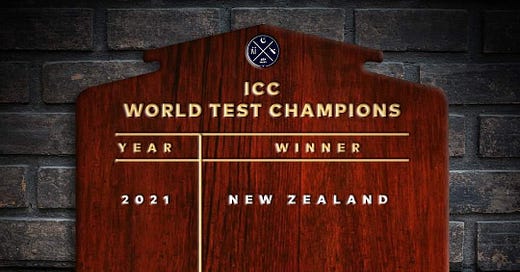We love a good David vs Goliath tale, especially one that comes with underdog connotations. The story of David upstaging Goliath, the story of Cinderella getting her prince. You know, when a group of people were shown records of two teams that were said to be competing in the final, they picked the one team with lesser previous success as their choice. We are crazy in love with underdogs.
Ross Taylor started his first class the year New Zealand domestic players went on strike over their state as professional athletes. The strike gave birth to a new era of professionalism. So, it was only fitting that he hit New Zealand's winning runs, it created a full circle moment. In a way, he represents the new New Zealand, the New Zealand of the modern era, the team that went from amateurs to champions.
This is the New Zealand that the majority of neutrals were supporting during the World Test Championship final. Of course the majority of New Zealand's supporters did not do so because they were clued in on New Zealand Test cricket history. This is not the kind of random piece of information the regular fan carries in their head. In fact, many who were rooting for New Zealand to win can barely name the New Zealand team.
And no, I am not talking about the people that don't like India for whatever reason. I am talking about the neutrals who suddenly found themselves rooting for New Zealand. These are the many were rooting for New Zealand for the same reason why a lot of us wanted the Jamaica bobsled team to win when we watched Cool Runnings. The same reason why we wanted Eddie the Eagle to do well.
Those that couldn't resist supporting New Zealand because they are a country of around 5 million (that is a population less than that of Bangalore - 8.4m) and were playing against India, a country of 1.5 billion. Because New Zealand's cricket budget ( who knows, maybe the entire budget of their sports ministry) is a fraction of the BCCI's annual budget. The people who were rooting for New Zealand because New Zealand was the underdog.
I mean, we just love underdogs, don't we? We are drawn to them the same way moths are drawn to light. The pull the underdogs have on us is difficult to explain, and sometimes it is a bit ridiculous, but it is there.
Many years ago - about 13 or 14 years ago - a group of very clever people (who put alphabets after their names) created an experiment that just shows how insanely ridiculous our love for the underdog is. The experiment was an odd one, an odd series of video clips.
The video clips were about lifeless, non-human object - shapes - making their way up a hill. They couldn't be bothered to come up with decent names for their shapes, maybe to prevent attachment, so they called them "single non-struggling entity" and "single struggling entity", and so on.
The first video clip showed the shape - the non-struggling entity - traveled up and down a slope without any difficulty. In the second video clip, the second shape - "single struggling entity" - though it looked just like the first one, had a lot of difficulty traveling through the same course, it really struggled moment it got to the slope.
The third clip featured the shape that they called "benign and non-struggling". It begins with one shape traveling with ease, though it slows down a bit when it gets to the slope. Then, while it is making it's way, a second and much faster shape - remember our non-struggling shape - comes from behind and overtakes it.
The fourth clip is a replay of the third one, but with a twist. Instead of simply overtaking the slower shape, the much faster shape takes things a step further. Immediately after overtaking the slower shape, it changes direction and rams itself onto the slower shape, knocking it back down the slope, before it proceeds up and over the hill. They called this "malicious and non-struggling".
Afterwards, they asked the participants the question, "On a scale of one to seven, how much did you root for each shape?" The participants' answers show that more people were rooting for the second shape much more than the first one. The more it struggled to make it's way up, the more they willed it to make it. Some could have even tried to shout some encouragement to it, just like how we shout positive stuff to the stragglers when we watch races or competitions. It was no different.
Where the third clip was concerned, the sight of a faster shape bearing down on the first shape made them root for the slower shape. And the results of the fourth clip, unsurprisingly, revealed that participants were rooting for the slower shape and actually felt sympathy for it after it was knocked down.
Our support for underdogs is insanely ridiculous, as I have said once before. Maybe that is why it is not limited to people and animals, but also extends to shapes and other random objects.
We have this strange emotional attachment to underdogs. We are madly in love with Cinderella and all want David to slay Goliath. It is unexplainable. More learned guys have tried to narrow down the reasons for this and just about failed to zone in on the one reason why we love underdogs.
One of the possible reasons why we root for underdogs could be that our moral minds are driven by a need for fairness. In a fair world, no one team is too powerful and dominant, there is equal opportunity for victory. Supporting the underdog lends our unequal universe a slight tilt in the right direction.
However, in this case, were rooting for the underdog, rooting for New Zealand, because we see ourselves in them. We identify with the underdog, whatever our station in life, we see ourselves as battling against the odds to reach our goals. Seeing an underdog win reminds us that we also can make it too. Not only that, but the underdog also represents the values we associate with ourselves; passion, grit and determination. Values that the New Zealand team so bravely lived and showed us throughout the World Test Championship.
The New Zealand team wanted to be a proper representation on the New Zealand people and their culture: humble and hard-working, a team that is always going to be very difficult to conquer despite being small. They were always going to scrap, fight tooth and nail. And in true underdog style, they did not let their limitations - financial, size, talent pool, etc. - limit them, they were going to rise above that. And they did. So we love them.
Thank you to everyone who has shown their appreciation of my work and this newsletter. I am entirely freelance and have no intention of putting content behind a paywall. However, for me to be able to continue producing more content, I depend on your patronage. So, please do support my work on Patreon.
Also, please encourage anyone whom you think may be interested in my work to subscribe.








